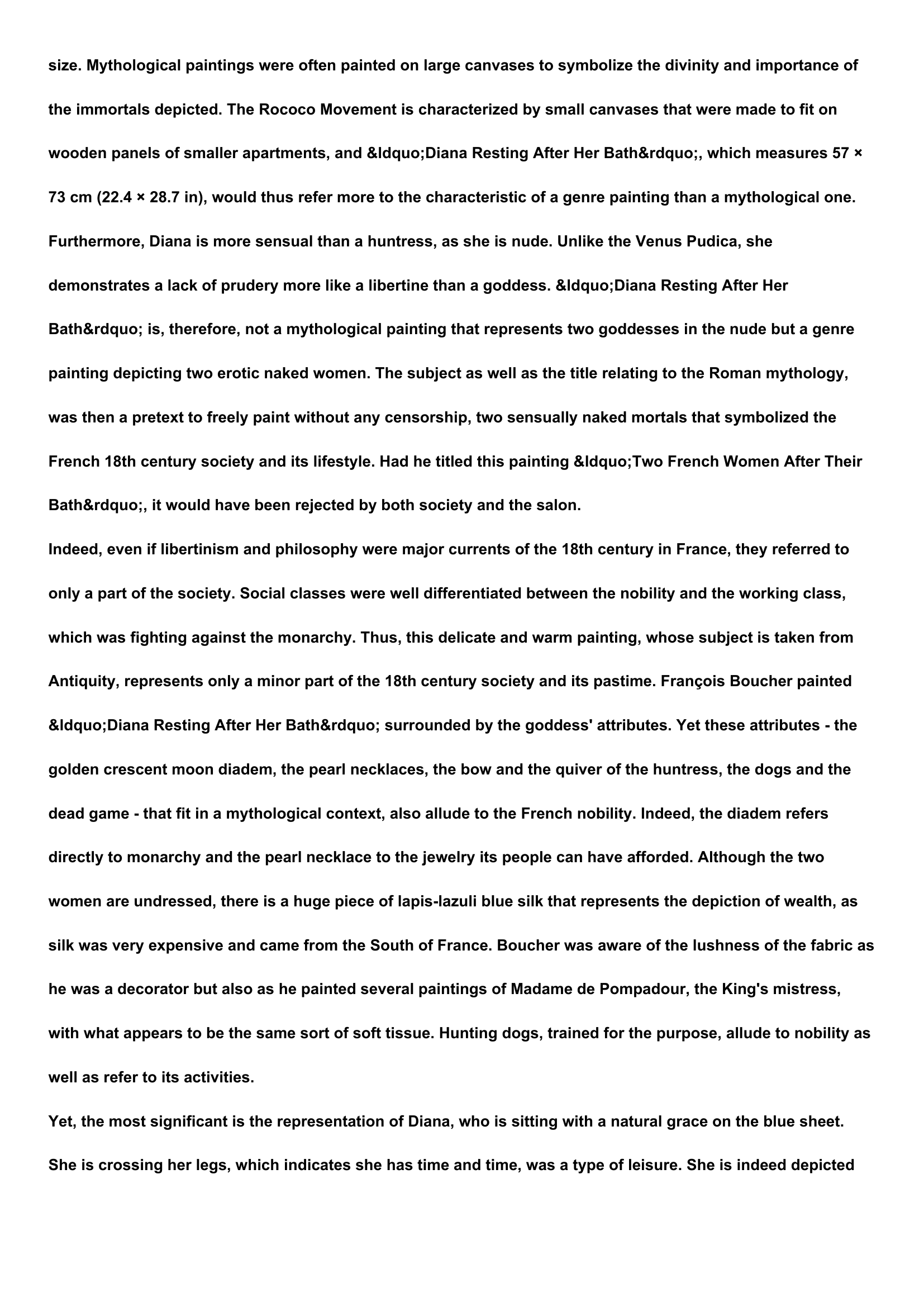Boucher's Diana resting after her Bath, not a mythological painting !!!
Publié le 09/05/2014

Extrait du document
«
size.
Mythological paintings were often painted on large canvases to symbolize the divinity and importance of
the immortals depicted.
The Rococo Movement is characterized by small canvases that were made to fit on
wooden panels of smaller apartments, and “Diana Resting After Her Bath”, which measures 57 ×
73 cm (22.4 × 28.7 in), would thus refer more to the characteristic of a genre painting than a mythological one.
Furthermore, Diana is more sensual than a huntress, as she is nude.
Unlike the Venus Pudica, she
demonstrates a lack of prudery more like a libertine than a goddess.
“Diana Resting After Her
Bath” is, therefore, not a mythological painting that represents two goddesses in the nude but a genre
painting depicting two erotic naked women.
The subject as well as the title relating to the Roman mythology,
was then a pretext to freely paint without any censorship, two sensually naked mortals that symbolized the
French 18th century society and its lifestyle.
Had he titled this painting “Two French Women After Their
Bath”, it would have been rejected by both society and the salon.
Indeed, even if libertinism and philosophy were major currents of the 18th century in France, they referred to
only a part of the society.
Social classes were well differentiated between the nobility and the working class,
which was fighting against the monarchy.
Thus, this delicate and warm painting, whose subject is taken from
Antiquity, represents only a minor part of the 18th century society and its pastime.
François Boucher painted
“Diana Resting After Her Bath” surrounded by the goddess' attributes.
Yet these attributes - the
golden crescent moon diadem, the pearl necklaces, the bow and the quiver of the huntress, the dogs and the
dead game - that fit in a mythological context, also allude to the French nobility.
Indeed, the diadem refers
directly to monarchy and the pearl necklace to the jewelry its people can have afforded.
Although the two
women are undressed, there is a huge piece of lapis-lazuli blue silk that represents the depiction of wealth, as
silk was very expensive and came from the South of France.
Boucher was aware of the lushness of the fabric as
he was a decorator but also as he painted several paintings of Madame de Pompadour, the King's mistress,
with what appears to be the same sort of soft tissue.
Hunting dogs, trained for the purpose, allude to nobility as
well as refer to its activities.
Yet, the most significant is the representation of Diana, who is sitting with a natural grace on the blue sheet.
She is crossing her legs, which indicates she has time and time, was a type of leisure.
She is indeed depicted.
»
↓↓↓ APERÇU DU DOCUMENT ↓↓↓
Liens utiles
- Jane, a young woman from England, has found a job in New York. A few days after her arrival she writes to her parents back home
- Medusa Greek One of the three Gorgons, the only one who was not immortal; her sisters were Stheno and Euryale.
- Omphale Greek The queen of Lydia who took the hero Heracles as her slave after he had desecrated the temple of Apollo.
- Poseidon Greek Sea god and one of the Olympian gods; son of Cronus and Rhea; brother of Zeus, Hades, Demeter, Hera, and Hestia; husband The Roman goddess Pomona displays her fruits of plenty in the painting by French artist Nicholas Fouche (1653-1733).
- Virgo (Virgin) Greek One of the constellations; sixth sign of the Zodiac, named for the maiden Erigone, who hanged herself from a tree after finding the grave of her murdered father, Icarius of Attica.

































